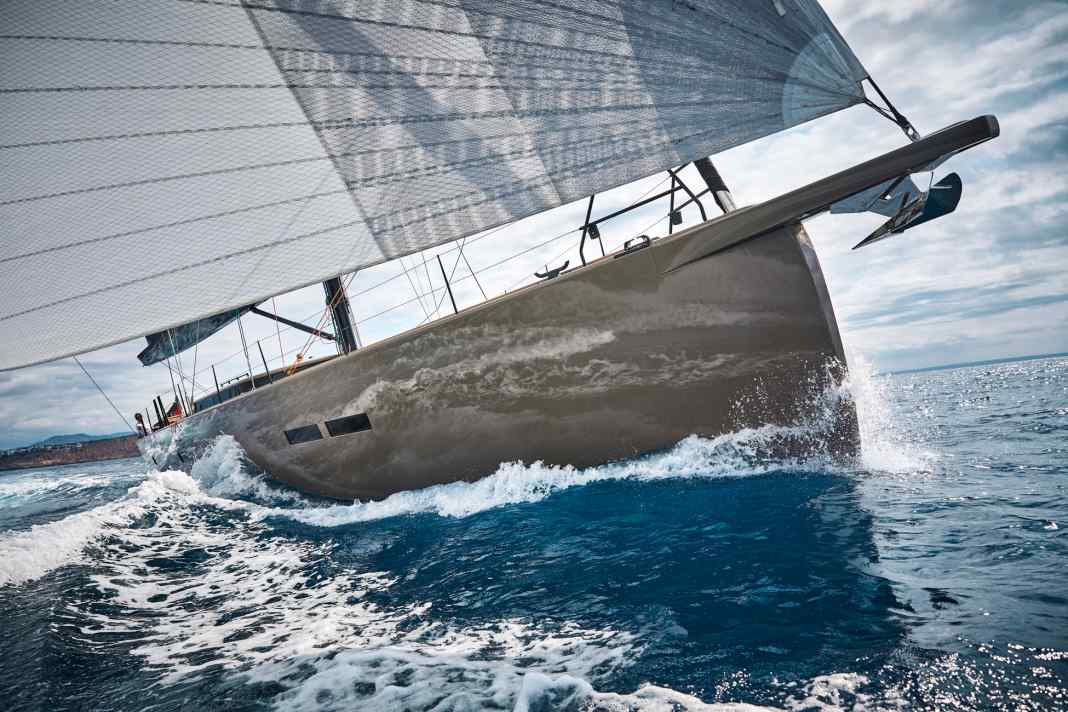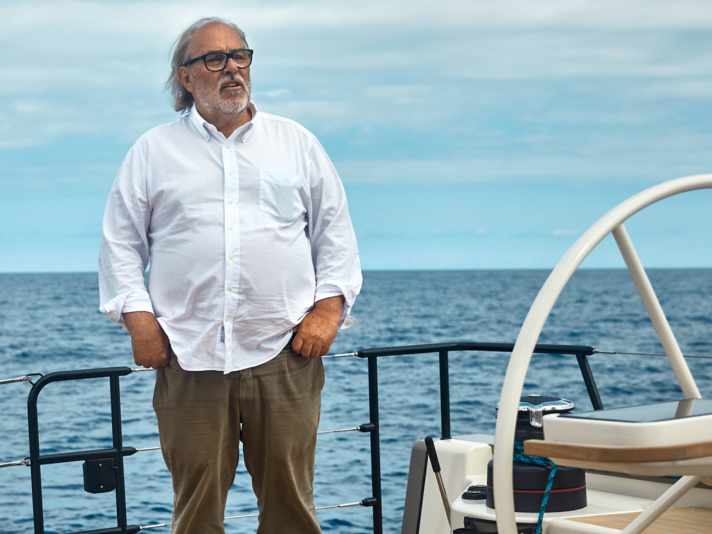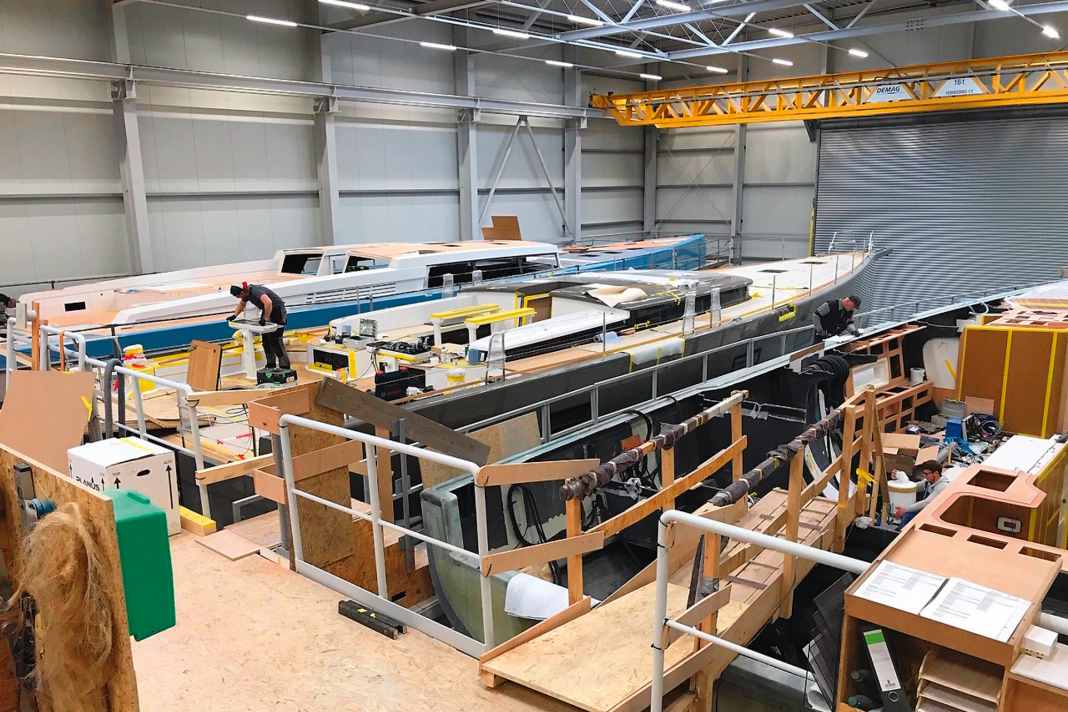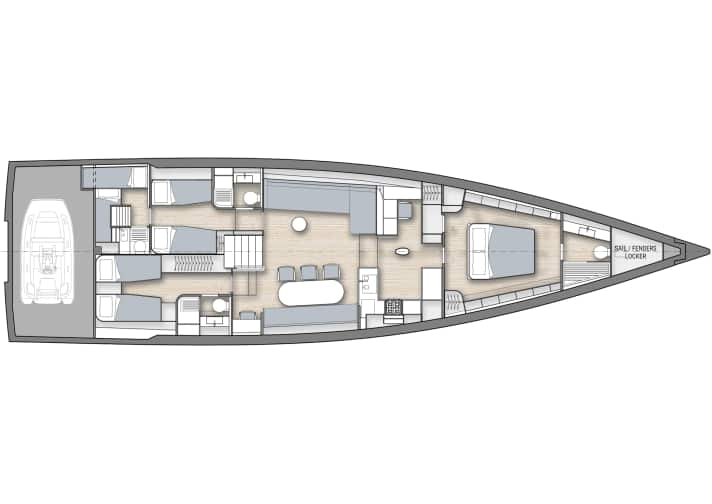





There are only a few people who have left a lasting mark on the German yachting industry in the post-war period and helped it to achieve international significance: GRP pioneer Willi Dehler is one of them, Bavaria's production genius Winfried Herrmann, the Judel/Vrolijk design team and someone who has clearly not wanted to stop when it comes to modern, innovative boatbuilding for around half a century.
We are talking, how could it be otherwise, about Michael Schmidt. The stubborn and changeable former OK dinghy sailor establishes the German agency for Canadian C&C yachts in Kiel, succeeds with repairs and completions of Admiral's Cuppers in a small shop on the grounds of the Hamburg marina, founds Hanseyachts in a former fishing cutter shipyard after the fall of the Berlin Wall and then acquires Moody, Fjord, Sealine and Dehler, and even takes the group public as the first German shipyard, selling his shares to the investor Aurelius.
This might also interest you:
His professional career is closely linked to his sailing career. Schmidt single-handedly sails C&C boats to success, his self-built Admiral's Cupper "Düsselboot", which was produced cheaply and imaginatively due to chronic underfunding, becomes an icon of modern ocean sailing, he wins the Cup with "Rubin VIII", he founds the first German America's Cup syndicate, and finally the man competes successfully in the Dragon class.
After the sale of Hanseyachts, Michael Schmidt's agenda was dominated by letting off steam instead of relaxing: travelling the Danube and Berlin waters on his aged motorboat "Heckmatrose", taking part in the classic circuit in the Mediterranean on the Anker-9-mR "Pandora" from 1907, cruising through the Danish South Sea on the Herreshoff ketch "Bounty". And on the Hanse 630 "Sticky Toffee" across the Atlantic to Brazil and later criss-crossing the Mediterranean.
Customised, aesthetic and high-performance boats
What others experience in an entire sailing career is only enough for the restless man for a few years. Schmidt: "The boat was too slow for me in the typical weaker Mediterranean winds. I then looked for something that would also work well under ten knots of wind, but found nothing." He did what was obvious to his nature and experience: he gathered good people around him, brought in his own ideas and had the boat built himself.
In collaboration with the designer Lorenzo Argento and the designer Sir David Chipperfield, the Brenta 80 DC was created (see also YACHT 25/15), which combines Schmidt's knowledge of sailing with his ideas of an individual, aesthetic and high-performance boat. The result was highly acclaimed, the job was just as much fun as the boat itself, and a new shipyard was created, Michael Schmidt Yachtbau, now YYachts. The speciality: The shipyard has the deck and hull built by external companies, such as Rega Yachts in southern Poland. Other well-known fast modern cruising yachts are built there for Italian brands such as Mylius or Vismara, but also smaller units such as the French Tri Libertist or the former dinghy cruiser JK 28 on German account.
YYachts' shipyard was built in 2016, not far from Hanseyachts in the Greifswald-Ladebow district. The hall measures 3,000 square metres, the adjoining office wing another 500. 35 employed boat builders and other experts or suppliers can work on up to six shells at the same time in the high hall.
The ceiling height allows this even when the keel is fitted, which is by no means a matter of course. Another special feature: the boats can be launched just 400 metres away, the basin is seven metres deep and directly connected to the Greifswald Bodden and therefore the Baltic Sea.
The sail area of the Y7 is extremely generous
YYachts is operating successfully. "In terms of the building, we could build more boats, but we want to grow slowly with our employees. At the moment, we build around five boats a year." These can also be one-offs, such as the sailing mini research vessel "Eugen Seibold" (see YACHT 9/2019), which was initiated by Gerald Haug, President of the German National Academy of Sciences Leopoldina, among others. However, the core business is the small series. In addition to the initial Y8, the somewhat smaller Y7 has developed into a high-volume ship, a design by US American Bill Tripp.
Like the Y8, the boat follows Schmidt's maxim of performance. The hull is made of vacuum-compressed foam sandwich with inner layers of carbon and epoxy resin for maximum strength, while the outer layers are made of E-glass for better point loading. The light and solidly built Y7 has a comparatively low overall weight of around 29 tonnes, with just under 10 tonnes being accounted for by the ballast, which is designed as a fixed T-keel with a draught of 3.50 metres as standard, but is optionally available as a telescopic keel (2.70 to 3.90 metres).
The surface area of the mainsail in particular is generous at 174 square metres, which is also due to the fathead geometry. There is no backstay and the spreaders are swept back by around 30 degrees - a configuration that is usually used on much smaller boats. The standard headsail is a self-tacking jib, just like on a Hanse, but at 123 square metres it is an impressive size. With these key data, the Y7 has a sail carrying capacity of 5.6 - which already puts it in the realm of pure regatta boats.
Relatively simple operation of the Y7
22 metres, 30 tonnes, 300 square metres: These are official key figures. The owner of the "Bella" we sailed takes it all in his stride, perhaps for lack of anything comparable, as it is his first boat. The entrepreneur came to his Y7 through a defect: he wanted to set off on holiday with his family from the Balearic Islands in his motorboat; a simple part on the engine had to be replaced, but could not be obtained in time. A friend with a Y8 had space and time and took the stranded family on a trip around Sardinia.
"That opened my eyes. The trip was so much more fun, especially in windy conditions, the movements are much more pleasant. And when I see what I spent every time I refuelled with the Mobo ... I preferred not to tell my children what we always had to blow out." The arguments worked, the convert ordered a Y7, took sailing courses and manoeuvre training together with his equally clueless skipper and off he went.
Both benefit from the boat's relative ease of use, which follows Schmidt's credo: "Sailing fun is best achieved with a simple boat that is reduced to its basics without sacrificing comfort." However, one could argue about what is complex and what is simple and where comfort begins and ends.
Twin rudders, twin engines
In any case, the deck layout enables handling by a small crew or, in combination with a good autopilot, even single-handed operation. Four large 80-calibre Harken winches, electrified of course, are available for halyards and sheets in front of and aft of the helmsman. The halyards and the foot of the mainsheet are out of the way of the guests sitting further forward. The self-tacking jib rolls electrically, as does the furler integrated into the bowsprit for the Code Zero. This means that the main work under sail is the recovery and furling of the mainsail, which Schmidt does not want to offer to furl into either the boom or the mast. The double rudder blades, which are positioned far outboard, also ensure easy handling and control.
And double the engines. Two 80 hp Nanni diesels with saildrives and rotary blade propellers not only propel the boat, but also improve manoeuvrability, and there is also a powerful retractable bow thruster. The twin engines have further advantages: At lower speeds, only one engine is used alternately, which reduces wear and maintenance costs, just as is usual on cats. And the system provides good redundancy, thus increasing operational safety.
The two gensets will not have to be used very often, as the sea trials have already shown. The boat also works as desired in ten knots of wind. It starts quickly, generates the apparent wind quite easily, is agile in manoeuvres and in changing winds and sails sufficiently high. With the Code Zero, a nice turbo can be added and the Y7 accelerates quickly to speeds beyond the wind speed. It steers fantastically and directly enough, and the handling also fulfils all wishes. However, it is conceivable that the long path through the wide working cockpit from leeward to windward or vice versa has the potential to be awkward; a path of almost six metres can be long and steep when heeling.
Various options for interior fittings
For the interior, Schmidt opted for a young Scandinavian team this time: Norm Architects from Copenhagen cultivate a reduced, uncluttered yet warm style, a combination that is well worth seeing on board a modern yacht. Schmidt describes the design as a combination of Danish and Italian elements.
The interior layout in the light and airy saloon, which takes up around a third of the area, is exciting: The main bulkhead houses the galley, which is known as a galley in this size of boat. Opposite is an office niche with a wine cabinet. Behind it is the elongated lounge, opposite which is the dining area with a bench and delicate chairs. Aft of this is a navigation corner with seat, some electrics and electronics. Aft is another guest cabin and a crew cabin, accessible from the cockpit. The owner's area with a completely free-standing double bed is forward. In the stern is a lazarette, a garage for a dinghy up to 3.45 metres long and more. The stern is closed to keep the space dry, and the dinghy is craned into the ship from above through a large hatch via the main boom.
And all of this is just one option; there are various possibilities for design and customisation, including individual construction. The "Bella" owner is completely enthusiastic about the boat and about sailing. So much so that he has already optioned a larger vehicle, a Y9.
Schmidt happens

YYachts is Michael Schmidt's fourth shipyard. It began with licence production for Canadian C&C yachts in Kiel, followed by the Wedel shipyard, where Admiral's Cupper, among others, were completed, some of which Schmidt sailed himself. The former OK dinghy sailor achieved sporting success in this era with the radical "Düsselboot" and the "Rubin VIII", which helped win the Admiral's Cup for Germany in 1985. Schmidt founded Hanseyachts in 1990, was the first German shipyard to go public in 2007 and sold his shares in 2011.
Large boats, small quantities




YYachts was launched in 2014 as Michael Schmidt Yachtbau with the Brenta 80 DC (see also YACHT 25/2015). The shipyard operates in newly built halls in Greifswald and is less than 4,000 metres away from the Hanseyachts shipyard, which was also founded by Michael Schmidt in 1990. Hulls and decks for the YYachts are laminated by supplier shipyards and are then removed and completed in Greifswald.
Around five boats per year are produced in this way from the programme, which includes the Y7, Y8, Y9 and YX models. These are series-produced models that can be customised to the maximum in terms of the interior and surfaces. The hulls of all types are made from carbon-foam sandwich; Schmidt favours lightweight construction and boats with reduced equipment for high performance, which should be evident even at wind speeds well below ten knots.
Technical data of the Y7

- Design engineer: Bill Tripp
- Torso length: 21,68 m
- Waterline length: 20,35 m
- Width: 5,75 m
- Draught (hours): 3,50 m
- Weight: 28,9 t
- Ballast/proportion: 9,6 t/33 %
- sail area: 297,0 m²
- Sail carrying capacity: 5,6
- Price (without sail): 2.25 million €
The article was first published in 2021 and has been revised for this online version.

